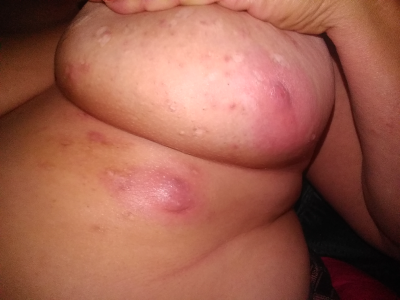Symptoms - Bumps
Reviewed by: HU Medical Review Board | Last reviewed: December 2020 | Last updated: March 2023
Hidradenitis suppurativa (HS) may begin gradually with small, somewhat itchy bumps. It may also come on suddenly with large, painful sores.1
HS is a painful, chronic inflammatory skin disease. It has a serious negative effect on quality of life. Recognizing HS bumps should improve early diagnosis and relieve the pain, appearance, odor, and disability caused by the condition.
What happens in HS?
Researchers have not proved the exact cause of HS. They believe that the body produces too much keratin, a tough protein that forms hairs and nails. The keratin plugs hair follicles, the tiny canals in the skin where hairs grow. Clogged hair follicles cause small, tender bumps under the skin. The bumps usually appear in a symmetrical (event) pattern on both sides of the body. The bumps last 7 to 15 days. Then they come and go in sporadic flares.1,2
The recurrent bumps are often misdiagnosed as boils. A typical boil has a pointed top containing pus. When burst, the boil drains onto the surface of the skin.1
HS bumps are rounded and usually rupture sideways under the skin. The plugged hair follicles also burst and spill their contents into the surrounding dermis, the thickest layer of skin. This causes inflammation and more bumps. The process repeats.1,3
Figure 1. Types of bumps and lumps associated with HS
Different types of bumps and lumps may appear with HS. They include:2,4,5
- Comedones – bumps that result when skin cells, bacteria, and oil block hair follicles. When open at the surface of the skin, comedones are blackheads. Closed comedones are whiteheads
- Papules – solid bumps up to 1 centimeter (less than half an inch) wide
- Pustules – bumps that contain pus
- Abscesses – painful, swollen lumps filled with pus. Burst hair follicles cause deep abscesses in the dermis. As pus spills out, it causes more inflammation
- Sinus tracts – narrow tunnels extending under the skin and sometimes connecting the bumps
Sinus tracts in skin have nothing to do with nasal sinuses in the head. Repeated clogging and bursting of hair follicles cause sinus tracts that drain pus to form. Pus contains dead skin cells, oil, bacteria, and white blood cells activated by the immune system to fight the bacteria. An odor comes from decomposing bacteria.4,5
Sinus tracts are the distinctive trait of HS. They also are the feature that is hardest to treat.3
What happens after the bumps?
As HS bumps heal, they leave raised scars. Sinus tracts may develop dense, ropelike scars that crisscross an area that was inflamed.6
In addition to their appearance, the scars may cause other problems. They may result in contractures. This is permanent tightening of muscles, tendons, skin, and other tissues that prevent normal movement. People who have contractures may not be able to lift their arms or separate their thighs, leaving them disabled.6,7
The pain, odor, pus, appearance, and disability of HS often cause social, employment, and mental health problems. Effects may include:8-10
- Embarrassment, social isolation, and sexual dysfunction
- Loss of work days and productivity, which may then reduce chances for career advancement
- Depression and anxiety

How is it treated?
Different medical and surgical treatment options are available. An experienced dermatologist working with a care team can personalize treatment, depending on the goals of the person with HS and the features and severity of their disease.
